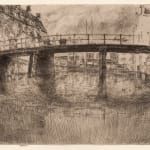James Abbott McNeill Whistler (1834-1903)
Around 1885, the center of the art world had moved away from the coast and countryside and back to the city making Amsterdam a magnet for foreign artists. Not on the same scale as London or Paris, it was certainly worth a visit, if only for its picturesque appearance and the seventeenth-century paintings in the museums. Whistler came to Amsterdam in 1889, where he exhibited his etchings along with the Dutch Etching Club. Treading in the footsteps of Rembrandt, Whistler saw Amsterdam, albeit through a Japanese lens, the trend towards the end of the nineteenth century. Truncated views of slightly arched bridges in Hiroshige and Hokusai, provide poetic and ethereal aspects as they traverse the shimmering surface of the canal channeling Rembrandt via Japonisme. The Amsterdam prints are the grand finale of Whistler’s etching career. His wife reported from Amsterdam that Whistler thought that “these plates will be among the finest he has done as they are very elaborate in character, and as they come from the country of the Knickerbockers they ought to be a great success in New York.”
Although the structure of the composition was established in the first state, Whistler’s reworking of the plate through all five states, with the addition of myriad lines, shading, cross-hatching in both etching and drypoint, results in a radically altered look: the final state is a darker, more dramatic, indeed even stormier rendering of what in the first state appeared to be a relatively placid scene. Interestingly, Whistler left much of the area in the upper right corner of the composition unfinished, leaving the bridge unattached.
Since Whistler’s visit, the bridge has disappeared: the Boltensgrachtje and the buildings were torn down around 1930. The canal ran roughly parallel to the tunnel under the IJ, near the Jewish quarters of Rembrandt’s old stomping ground. Like his predecessor, Whistler’s habit of carrying around small grounded copper plates, using them to jot down impressions on the spot as if recording them in pencil in a sketchbook, produced these equally virtuoso compositions.
Other final states of Bridge, Amsterdam can be found in the collections of the National Gallery of Art, Washington, DC., the Boston Public Library, MA, Colby College Museum of Art, ME, and Bibliothèque nationale de France, Paris, making it the largest iteration of the fifth state.[1]
[1] https://etchings.arts.gla.ac.uk/catalogue/etchings/etchlist/?catno=K409
Provenance
Walter Steuben Carter
Vivian and Meyer P. Potamkin, Philadelphia
Sotheby’s, New York, May 11, 1989, lot 302
Samuel Josefowitz, Pully, Switzerland



